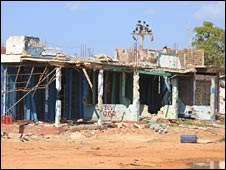 We travelled at breakneck speed across north-eastern Sri Lanka in an armoured personnel carrier. The land was flat, the reddish unmetalled road long and straight.
We travelled at breakneck speed across north-eastern Sri Lanka in an armoured personnel carrier. The land was flat, the reddish unmetalled road long and straight.
This hot, dry midday there was no-one and nothing to impede us from hurtling along. No women and children walking in the road, as you expect in South Asia. No oxen, goats or chickens.
For this is a depopulated land, the country stretching eastwards from the former headquarters of the Tamil Tiger (LTTE) rebels, Kilinochchi.
It has been recaptured from them in the past few months, the culmination of a Sri Lankan army campaign that began in September 2007 and gathered pace.
Rubble
The destruction is everywhere to see. Many buildings are badly damaged or semi-collapsed – including a little church, a reminder of this island’s diversity. Or the fishermen’s co-operative union building.
Rubble is everywhere.
In the initial weeks and months after the battles, the people were taken to government camps where they were housed and given food and water.
For now "there are only army troops in this area", explained the military spokesman, Brig Udaya Nanayakkara.
"Once all these civilians have been rescued, once the rest of the area has been cleared, then we’ll have to start developing it. We’ll have a tremendous development work after the military action."
Then, among palm trees as we neared the ocean at Iranapalai, there were suddenly people. There was no mistaking who they were – Tamil refugees who had fled the LTTE-controlled zone.
Refugee ordeal
We had seen thousands such people on television for the past four days. Now we were confronted with their reality close-up.
They walked listlessly, as if in a state of shock. They had – we were told – passed through military checks having left the conflict area a day or two before.
Some stared straight ahead. Others were willing and able to talk to us, even smiling a bit. With little time to talk, they told of how they lived in bunkers.
Some said they had too little food or water; others had enough. But several spoke of the heavy shelling they had had to endure. They were happy to be out. The LTTE had tried to stop them escaping, one told us.
The army, our hosts, were not keen that we should speak for long. They guided us off in one direction to the next stage of our programme, and channelled the refugees elsewhere. Down one lane we could see hundreds but not meet them.
Smoke rising
We moved a little further by road. Here, there were discarded belongings and hundreds more people sitting in the fields, waiting – to go to the camps, we assumed.
Within minutes we had reached the end of our road, the closest possible point to the frontline – perhaps the last frontline of a 26-year war. This was the extension of the Nanthi Kadal lagoon, the waterway refugees had waded across to leave the spit of land where they had been trapped.
There was a road bridging the water but soldiers blocked it. Any further and we would have been at risk of landmines, they told us – not to mention the fighting still going on across the shallow water and its green vegetation, away to the south-east.
From there we heard repeated booms and saw smoke rising.
Officers pointed across the channel to the long "bund" or mud wall built by the LTTE and breached by the army last Monday, which enabled the massive flight of people.
Spoils of war
Earlier, at Kilinochchi, we had breakfasted and been given military presentations in the impressive, air-conditioned buildings which used to be Tiger headquarters.
Under a picture of the Sri Lankan president, Brig Shavendra Silva of the 58th Division showed us pictures of every facet of 18 months of war – captured LTTE bunkers and even swimming pools and water scooters, LTTE fighters taken prisoner or, we were told, nursed back to health, gruesome pictures of rebels’ bodies.
The main event was outside: garlanded with leaves, a massive tank said to have been taken from the LTTE in recent months, and a huge display of weapons and military hardware which had been captured from the rebels, we were told, in early March.
(For updates you can share with your friends, follow TNN on Facebook and Twitter )
